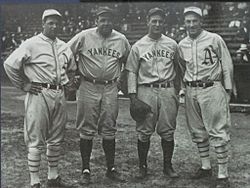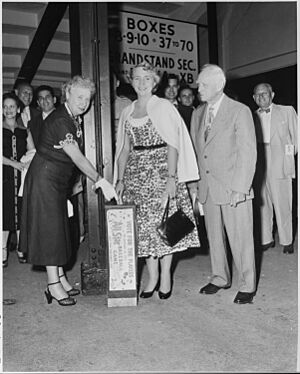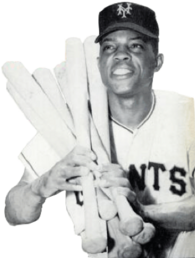Major League Baseball All-Star Game facts for kids
Quick facts for kids Major League BaseballAll-Star Game Midsummer Classic
|
|
|---|---|

2009 Major League Baseball All-Star Game in St. Louis
|
|
| Frequency | Annual |
| Location(s) | Varies (see text) |
| Inaugurated | 1933 |
| Previous event | July 15, 2025 (Truist Park, Cumberland, Georgia) |
| Next event | July 14, 2026 (Citizens Bank Park, Philadelphia, Pennsylvania) |
| Participants | American League National League |
| Organized by | Major League Baseball |
The Major League Baseball All-Star Game, also known as the "Midsummer Classic", is a special annual baseball game. It is organized by Major League Baseball (MLB). In this game, the best players, called all-stars, from the American League (AL) play against the best players from the National League (NL). Fans choose the starting players. Managers pick the pitchers, and other players are chosen by players and managers.
This exciting game usually happens in the middle of July. It marks the halfway point of the MLB season. During this time, there are no regular season games for a few days. This break allows everyone to enjoy the All-Star events. Many fun activities and celebrations take place around the game.
No official MLB All-Star Games were held in 1945 or 2020. This was due to World War II travel rules and the COVID-19 pandemic. From 1959 to 1962, two All-Star Games were played each season. The most recent All-Star Game was played on July 15, 2025. It took place at Truist Park in Cumberland. This is the home stadium of the NL's Atlanta Braves.
Contents
History of the All-Star Game
Baseball teams sometimes played special games to help families of players who had passed away. For example, the Addie Joss Benefit Game in 1911 raised money for a player's family.
The very first All-Star Game was held on July 6, 1933. It took place at Comiskey Park in Chicago. This game was part of the 1933 World's Fair. Arch Ward, a sports editor, first suggested the idea. The American League president, Will Harridge, helped make it happen. It was meant to be a one-time event. But it was so successful that it became an annual tradition.
From 1959 to 1962, two All-Star Games were played each season. This was done to raise more money for the players' pension fund. This practice stopped when team owners agreed to give players a bigger share of the money from just one game.
More than 2,000 different players have been chosen for an All-Star Game. This includes games from 1933 up to 2025.
Where All-Star Games Are Played
MLB decides where the All-Star Game will be held each year. They often choose cities with new baseball stadiums. They also pick cities that have not hosted the game in a long time, or ever. This means some cities have hosted more games than others.
Cleveland Stadium and the old Yankee Stadium have each hosted four All-Star Games. This is the most for any stadium. New York City has hosted more games than any other city, with nine games in five different stadiums. The Tampa Bay Rays are the only team that has never hosted an All-Star Game.
The host city usually switches between the American and National Leagues each year. An AL team hosts in odd-numbered years, and an NL team hosts in even-numbered years. However, this rule has been broken several times. For example, the NL hosted two games in a row in 2006 and 2007. They also hosted four straight games from 2015 to 2018.
In the early years, some cities had two teams sharing the same ballpark. For example, in Philadelphia, the Athletics (AL) and Phillies (NL) both played at Shibe Park. This meant the All-Star Game could return to the same stadium more quickly.
The "home team" in the All-Star Game is usually from the league of the host city. For example, if an AL team hosts, the AL is the home team. The only exception was in 2016. The AL was the home team even though the game was in an NL park. This was because the winning league used to get home-field advantage in the World Series. MLB wanted to make sure the NL didn't get this advantage too many times in a row. Since 2017, the host team's league is always the home team again.
How All-Star Teams Are Chosen
Managers and Coaches
Since 1934, the managers for the All-Star Game are usually the managers of the teams that won their league championships the year before. They also pick their own coaching staff.
Sometimes, a manager might have changed teams or even retired. For example, Tony La Russa managed the National League team in 2012. He had retired after winning the World Series with the St. Louis Cardinals in 2011.
There have been a few times when the usual rule was not followed. This happened in 1965 because both winning managers had left their teams. It also happened in 1995 because the 1994 season ended early due to a strike. In that case, the managers of the teams with the best records were chosen.
Players for the All-Star Game

The number of players on each All-Star team has changed over the years. In 1933, there were 18 players. Since 2010, each team has 34 players.
One rule that sometimes causes debate is that every MLB team must have at least one player on an All-Star roster.
In 2010, MLB made some new rules for the All-Star Game:
- Teams now have 34 players.
- The designated hitter (DH) rule is used in all games. This is true even in National League ballparks. (The NL started using the DH in all games in 2022, so this rule is now less important).
- Pitchers who started a game on the Sunday before the All-Star Game are replaced on the roster. But they are still recognized as All-Stars.
- Managers can choose one position player who can re-enter the game. This is if another player gets hurt or is ejected.
Players are chosen in a few ways:
- Fan Voting: Fans vote for the starting position players. This is done online. Sometimes, fans from very popular teams vote a lot for their players. This can lead to many players from one team being chosen.
- Player Voting: Players, coaches, and managers vote for 16 players. This includes pitchers and backup players for each position.
- Manager Selection: The manager of each All-Star team chooses eight more players. They talk with other managers and the Commissioner's Office. This ensures that every team has at least one player on the roster.
- Replacements: If a player gets hurt or decides not to play, the manager and Commissioner's Office choose a replacement.
All-Star Uniforms
For many years, players wore their regular team uniforms during the All-Star Game. Game-specific uniforms were made for batting practice and the Home Run Derby.
From 2021 to 2024, MLB and Nike created new All-Star Game uniforms each year. Players wore these special uniforms during the game itself. However, starting with the 2025 game, MLB went back to players wearing their regular team uniforms for the game.
All-Star Caps
Since 2014, players have worn special All-Star Game caps. For practices and the Home Run Derby, they wear caps with colors for their league. For the game, they wear a cap with their team's logo. It also has the All-Star Game logo on the side.
How Players Were Selected in the Past
In 1933 and 1934, fans picked the starting players. Managers chose the rest. From 1935 to 1944, and in 1946, managers picked the whole team.
In 1947, fans could vote for eight starting players again. But in 1957, fans of the Cincinnati Reds voted so much that seven Reds players were chosen to start! Commissioner Ford Frick had to step in. He removed two Reds players from the starting lineup. Because of this, fan voting was stopped for 12 years. Players, coaches, and managers chose the starters instead.
Interest in the game seemed to drop without fan voting. So, fan voting for the starting players was brought back for the 1970 game.
Over time, the voting for outfielders changed. Instead of voting for left, center, and right fielders separately, fans just voted for the top three outfielders.
Rico Carty in 1970 and Steve Garvey in 1974 were the first players chosen by fans as "write-in" candidates. This means their names were not on the ballot, but fans wrote them in.
From 2002 to 2018, fans could also vote for one last player in a "Final Vote."
Before 2003, managers chose all the reserve players and pitchers. But managers were sometimes criticized for picking players from their own team. This happened even if other players were more deserving. So, player voting was brought back in 2003.
In 2009, an extra pitcher was added to each team. In 2010, an extra position player was added. This brought the total to 34 players per team.
The rule that every team must have at least one All-Star is still debated. Supporters say it keeps fans interested. Opponents say it means some of the very best players might be left out.
Ballot Stuffing
In 1957, Cincinnati Reds fans tried to "stuff the ballot box." They voted so much that seven Reds players were chosen to start the All-Star Game. An investigation showed that more than half the votes came from Cincinnati. The Cincinnati Enquirer newspaper had even printed ballots that were already marked for the Reds players. Commissioner Ford Frick changed the lineup. He replaced two Reds players with Willie Mays and Hank Aaron. He also took away fan voting rights for future games.
To prevent this from happening again, when fan voting returned in 1970, each team was given the same number of ballots.
In 2015, fans of the Kansas City Royals were accused of ballot stuffing. Eight of their players were leading in the votes. MLB canceled 65 million votes that were found to be fake. In the end, only four Royals players started the game.
Designated Hitter Rule
In 1989, a designated hitter (DH) was allowed in the All-Star Game for the first time. For many years, the DH rule was used only if the game was in an American League ballpark. In National League ballparks, pitchers would usually bat.
In 2010, Major League Baseball announced that the DH rule would be used in every All-Star Game. This means both teams use a DH, no matter where the game is played. The 2011 game was the first played in a National League park with a DH.
All-Star Game MVP Award
The All-Star Game Most Valuable Player (MVP) Award is given to the best player in each All-Star Game. This award started in 1962. It was first called the Arch Ward Memorial Award, named after the person who created the All-Star Game.
The name changed a few times. In 2002, it was named The Ted Williams Most Valuable Player Award. This was to honor former Boston Red Sox player Ted Williams, who had passed away that year.
Ties, Rain, and World Series Advantage
The first tie in an All-Star Game happened on July 31, 1961. The game ended 1-1 after nine innings because of rain. Another game in 1952 was also shortened by rain.
The 2002 All-Star Game in Milwaukee ended in a tie. Both teams ran out of players who could pitch. Commissioner Bud Selig declared the game a 7-7 tie after 11 innings. Fans were very unhappy about this.
To make the game more exciting, MLB decided to give the winning league a special prize. From 2003 to 2016, the league that won the All-Star Game got home-field advantage in the World Series. This meant their team would host more games in the World Series. Since 2017, home-field advantage in the World Series is given to the team with the better regular season record.
Even with the old rule, managers sometimes held back players. They did this to make sure they had enough players if the game went into extra innings. This sometimes meant popular players didn't get to play. Since 2010, managers can choose one position player who can re-enter the game if needed.
Since 2022, if an All-Star Game is tied after nine innings, there are no extra innings. Instead, the teams have a "swing-off" competition. This is like a mini Home Run Derby. Three players from each team take three swings. The team that hits the most home runs wins the swing-off. The game itself is still recorded as a tie. This rule was first used in the 2025 All-Star Game. The National League won the swing-off 4-3.
All-Star Game Streaks and Records
Ninety-three All-Star Games have been played. This includes the years with two games. The American League has won 48 games, the National League has won 45, and there have been 2 ties.
The All-Star Game has seen periods where one league was much stronger.
- From 1933 to 1949, the American League won 12 out of 16 games.
- From 1950 to 1987, the National League was dominant. They won 33 games, with 8 losses and 1 tie. This included winning 19 out of 20 games from 1963 to 1982. They even won 11 games in a row from 1972 to 1982.
- Since 1988, the American League has been stronger. They have won 28 games, with 8 losses and 1 tie. This includes a 13-game unbeaten streak from 1997 to 2009.
The AL has scored more runs overall, with a 394-386 advantage.
The longest All-Star Game in terms of innings lasted 15 innings. This happened twice, in 1967 and 2008. The 2008 game was the longest in time, lasting four hours and 50 minutes.
All-Star Game Schedule
Since 1963, the All-Star Game has usually been played on a Tuesday in July. In 1983, it was played on a Wednesday night. This was to celebrate 50 years since the first game.
Sometimes, the game has been moved. In 1969, it was rained out and moved to Wednesday afternoon. In 1981, it was moved to a Sunday in August because of a players' strike. This was the only game played on a weekend.
The game was first played at night in 1942. Since 1970, all All-Star Games have been played at night.
Twice, the All-Star Game was postponed due to travel restrictions. In 1945, it was due to World War II. In 2020, it was due to the COVID-19 pandemic.
As mentioned, two All-Star Games were played each season from 1959 to 1962. This was to raise money for players' pensions. But it was stopped because it made the event less special.
The 2021 All-Star Game was moved to Denver. It was originally planned for Atlanta. MLB moved it because of a new election law in Georgia. MLB stated it supports voting rights for all Americans.
Other All-Star Events
Besides the main game, several other fun events happen in the host city. These are also shown on TV.
- The Home Run Derby is a contest where powerful hitters try to hit the most home runs. It has been held the day before the All-Star Game since 1985. The most recent champion is Cal Raleigh from the Seattle Mariners.
- Since 1999, the All-Star Futures Game has been played. This game features young, talented players from the minor leagues. One team is from the United States, and the other is from other countries.
- Since 2001, the All-Star Legends and Celebrity Softball Game takes place. This game has former baseball stars and celebrities from music, movies, and TV. It is played before the Home Run Derby.
- Since 2021, the Major League Baseball Draft has been held during the All-Star Break. It takes place in the same city as the All-Star Game.
- The HBCU Swingman Classic started in 2023. It is for players from historically black colleges and universities.
All-Star Firsts and Records
- All-Star Firsts
- First All-Star in the Baseball Hall of Fame: Babe Ruth, 1936
- First rookie All-Star: Joe DiMaggio, 1936
- First All-Stars of African descent: Roy Campanella, Larry Doby, Don Newcombe, and Jackie Robinson, 1949
- First All-Star Game MVP: Maury Wills, 1962
- All-Star Game Records
(Remember, from 1959-1962, there were two All-Star Games each season. No games were played in 1945 and 2020.)
- Most All-Star Game appearance seasons: Hank Aaron, 21
- Most All-Star Games: Hank Aaron, 25
- Most All-Star Game MVP Awards: Willie Mays, Steve Garvey, Gary Carter, Cal Ripken Jr., and Mike Trout, all with 2
- Most All-Star Game hits: Willie Mays, 23
- Most All-Star Game runs batted in: Ted Williams, 12
- Most All-Star Game home runs: Stan Musial, 6
- Most All-Star Game grand slams: Fred Lynn, 1
- Most All-Star Game stolen bases: Willie Mays, 6
- Most All-Star Game wins (pitcher): Lefty Gomez, 3
- Most All-Star Game strikeouts (pitcher): Don Drysdale, 19
See also
- List of Major League Baseball All-Star Games
- List of Major League Baseball All-Star Game broadcasters
- List of Major League Baseball All-Star Game starting pitchers
- Major League Baseball All-Star Game records
- Negro league East–West All-Star Game
- Triple-A All-Star Game
Similar Events in Other Sports
- MLS All-Star Game (Soccer)
- NBA All-Star Game (Basketball)
- NFL Pro Bowl Game (American Football)
- NHL All-Star Game (Ice Hockey)




